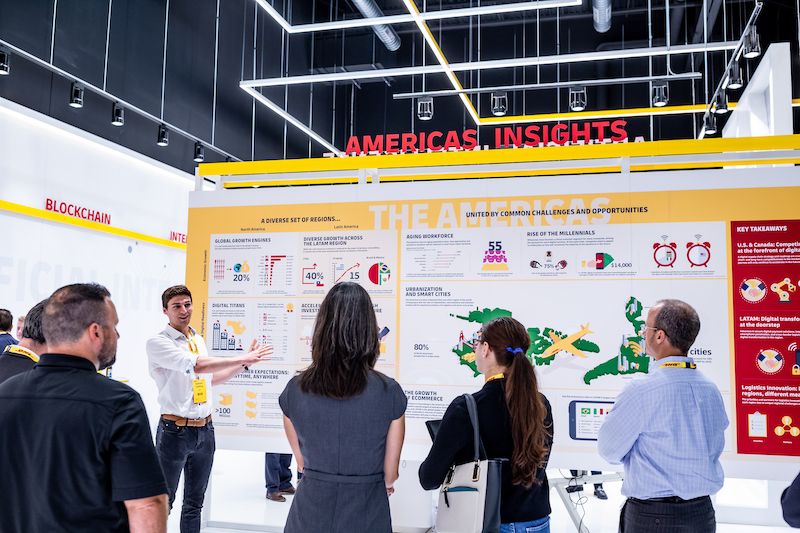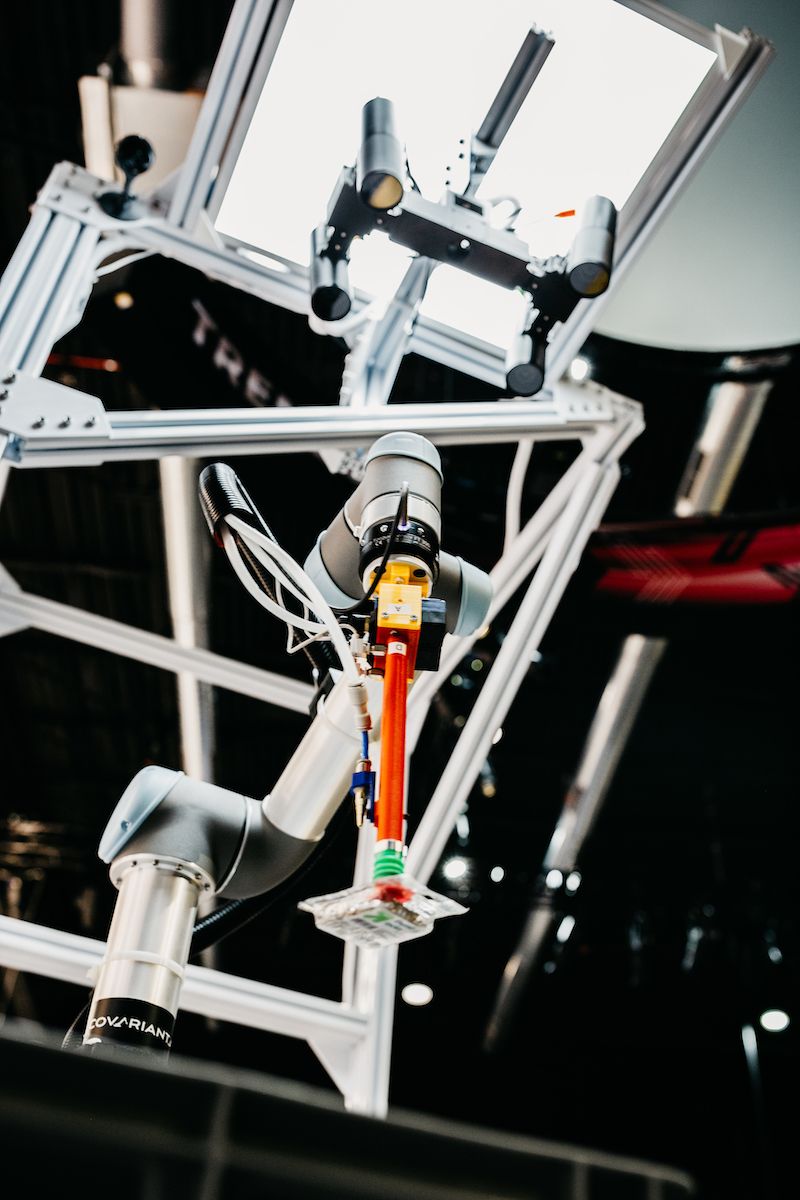In 30 years, the stuff we buy will be translated into code and manifested at 3D printing facilities across the globe. Self-driving robots will whir through warehouses, filling delivery requests exponentially faster than a human ever could. Individuals who still have manual jobs will regularly be immersed in virtual reality games teaching them to work as efficiently as possible.
This week, DHL opened its first North American Innovation Center in Rosemont as a research and design hub dedicated to making these ambitious visions a reality.
“Getting people here to see the data, engaging them — customers, partners — to really understand what are their needs, what are their requirements and, from the journey, create new solutions,” said Matthias Heutger, DHL’s global head of innovation.
“It’s really about being close to our customers and close to our operations.”
‘Not just creating things’
DHL has spent the last year constructing the 28,000 square-foot smart building, with the help of $1 million in funds from the village of Rosemont. DHL expects to hire up to 20 people to initially power the new center — its third such center worldwide — although that could change, depending on demand.
“We want to make sure we’re creating meaningful innovation and not just creating things nobody needs,” Heutger said, adding that the company’s two other Innovation Centers are growing “exponentially.”
We want to make sure we’re creating meaningful innovation and not just creating things nobody needs.”
Founded in 1969, DHL opened its first Innovation Center in Troisdorf, Germany in 2007, and its second, the Asia Pacific Innovation Center, in Singapore in 2015.
Rosemont’s Innovation Center is divided into three parts: a “Visions Portal,” where the firm outlines what it expects logistics to look like by 2050; a “Trends Lab,” where it explores different technologies powering logistics in the next 10 years; and a “Solution Space,” where DHL shows off some of the technologies it’s currently using.
Customers like Apple, Panasonic or Samsung will visit the facility, receive a customized tour of each section and, at the end, meet with DHL representatives to discuss how to solve their logistics hang-ups — whether that be distribution, last-mile delivery, customer contact or more.

Keeping up with Amazon, eBay and Alibaba
Ken Allen, CEO of the e-commerce division at DHL, said the facility will also address the challenges DHL is facing, like globalization, which he credited with increasing competition and changing consumer expectations around delivery speed and options.
Allen said DHL needs to innovate to keep up with global customers like Alibaba, Amazon and eBay because, if they don’t, companies will introduce their own shipping solutions. He named JD.com as an example, saying the Chinese firm started as a marketplace and now has been transitioned into a logistics hub that serves southeast Asia.
“We’ve got to keep innovating and moving forward to make sure that we can service these customers. Otherwise they become our competitors,” Allen said.
One of the biggest challenges DHL is currently experiencing is spikes in demand for shipping services. Traditionally, peaks occurred around Christmas, but the internet has now accelerated this process, creating immediate demand for a products endorsed by celebrities like Beyonce. Globalization has also created introduced new busy seasons for holidays like Singles Day in China.
Allen said the peaks present a labor challenge, particularly around how to deliver small individual packages. The firm is piloting the use of robots to help delivering these goods, assist in mundane tasks like picking, fill worker shortages and, in regions like North America, save on labor costs.
“We need those robots in place to do some of these menial tasks and that allow people to be freed up for other things,” Allen said.
DHL’s challenges will, in some cases, drive investment. In November 2018, the logistics firm said it planned to invest $300 million through the end of this year to deploy new technologies to 350 of its 430 North American facilities.
Gina Chung, director of the Innovation Center, said the space is also intended as a place where DHL can collaborate with startups it’s invested in.
“Our general approach to innovation is always to partner because we’re a logistics company,” Chung said. “We have partnerships with these companies, give them feedback early on about what works, doesn’t work, refine the product for our industry.”
A world without global shipping?
Near the entrance of the Innovation Center is the “Visions Portal,” which features a short film about what logistics might look like in 2050, based on a 2012 study commissioned by DHL. In one scenario, DHL highlights dematerialization, or the idea that all products will become code, “beamed” to a local materializing center, and then printed by a 3D printer.
In another instance, DHL predicts that consumers will generate personalized product designs, items will be manufactured locally and that there will be a “rapid” acceleration of product life cycles, with items disposed of after five months. After watching the short film on what logistics could look like in 2050, DHL’s customers are then ushered into the “Trends Lab,” a physical manifestation of the firm’s Logistics Trend Radar report, which outlines technology trends DHL expects to drive change in society and business over the next 10 years.
The most recent iteration of the trends radar was published in June 2018, and outlines 28 technological and societal trends DHL expects to rise in the logistics world. Technology trends include the Internet of Things, smart glasses, augmented reality and more.
Wearables and the future of warehouse workers
During a media tour on September 10, Chung modeled a pair of Google Enterprise Edition glasses, or smart bifocals the firm has rolled out across multiple warehouse facilities for several customers.
DHL started piloting the technology in 2015 and, since then, Chung estimated that more than 100 European and North American warehouse workers have been outfitted with a pair, which connect to a center’s warehouse management system. The glasses illuminate to workers where a product is located, and allow individuals to use the glasses’ bluetooth to take a picture, scan an item into the system and place it into the correct bin.
Chung estimated the glasses cost DHL just over $1,000 a pair, cut worker training time in half, and result in at least 14 percent greater productivity.
Another section of the Trends Lab covers Internet of Things technology, and showcases a wearable device DHL is piloting across three facilities in the U.S. DHL partnered with the New York-based Kinetic to outfit workers with a wearable sensor that vibrates when a worker handles freight incorrectly.
By using this device, we want to avoid back injuries.”
“By using this device, we want to avoid back injuries, which not only improves our workforce, obviously, but they have reduced sick days and problems,” Chung said. “It also has commercial benefits for employers because you have less cost of healthcare associated with dealing with workplace injuries.”
A third section of the Trends Lab features a virtual reality headset, which immerses users into a virtual reality simulation of how to correctly load an air freight carrier. DHL has “gamified” the training process — awarding users points for completing a task correctly, subtracting points for inefficiencies — which Chung said helps the lesson stick, engage millennial workers and make it possible to prepare for crisis scenarios without actually experiencing a meltdown.

... and the robots, of course
After walking through the Trends Lab, DHL customers enter the third section of the Innovation Center — the “Solution Space,” where they see a few of the robotics solutions DHL has integrated into its operations. Chung credited some of the self-driving robots featured with increasing picking rates by 200 percent.
One robot is a motorized cart — powered by the French Effie Dence firm — that uses sensors to scan individuals workers’ legs and follow them around the warehouse. Workers drop items they pick into the bin, and it allows them to keep their hands free while they pick.
Visitors can also see a robot built by the Wilmington, Massachusetts-based Locus Robots, which wheels about large warehouses and works with human pickers to find and store items. Chung estimated that the average warehouse worker walks between nine and 13 miles daily. But with the help of Locus, she said workers’ walking distance is cut down “very significantly.”
“We’re interested in speeding up the work to make it faster, more efficient,” she said.




